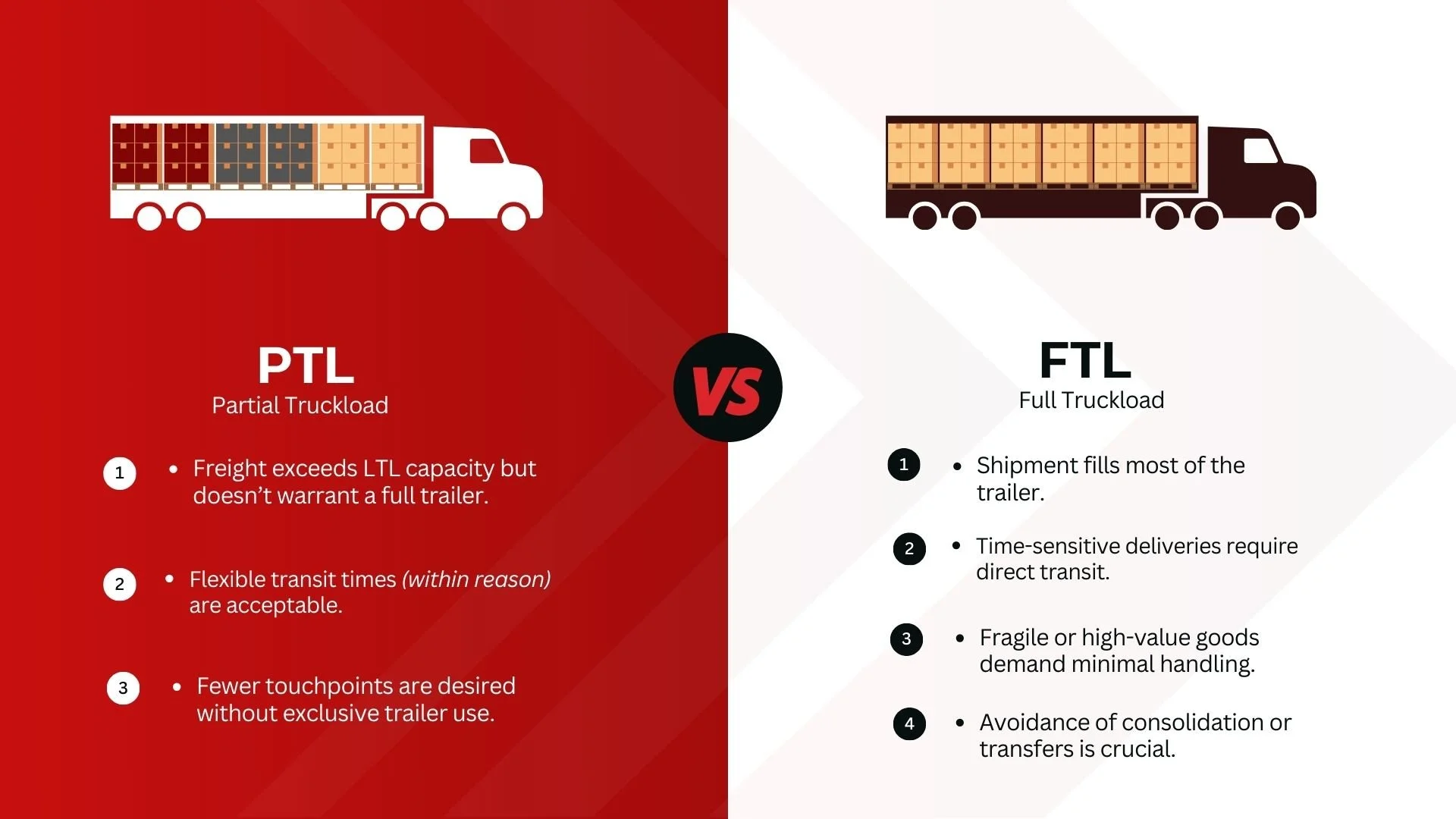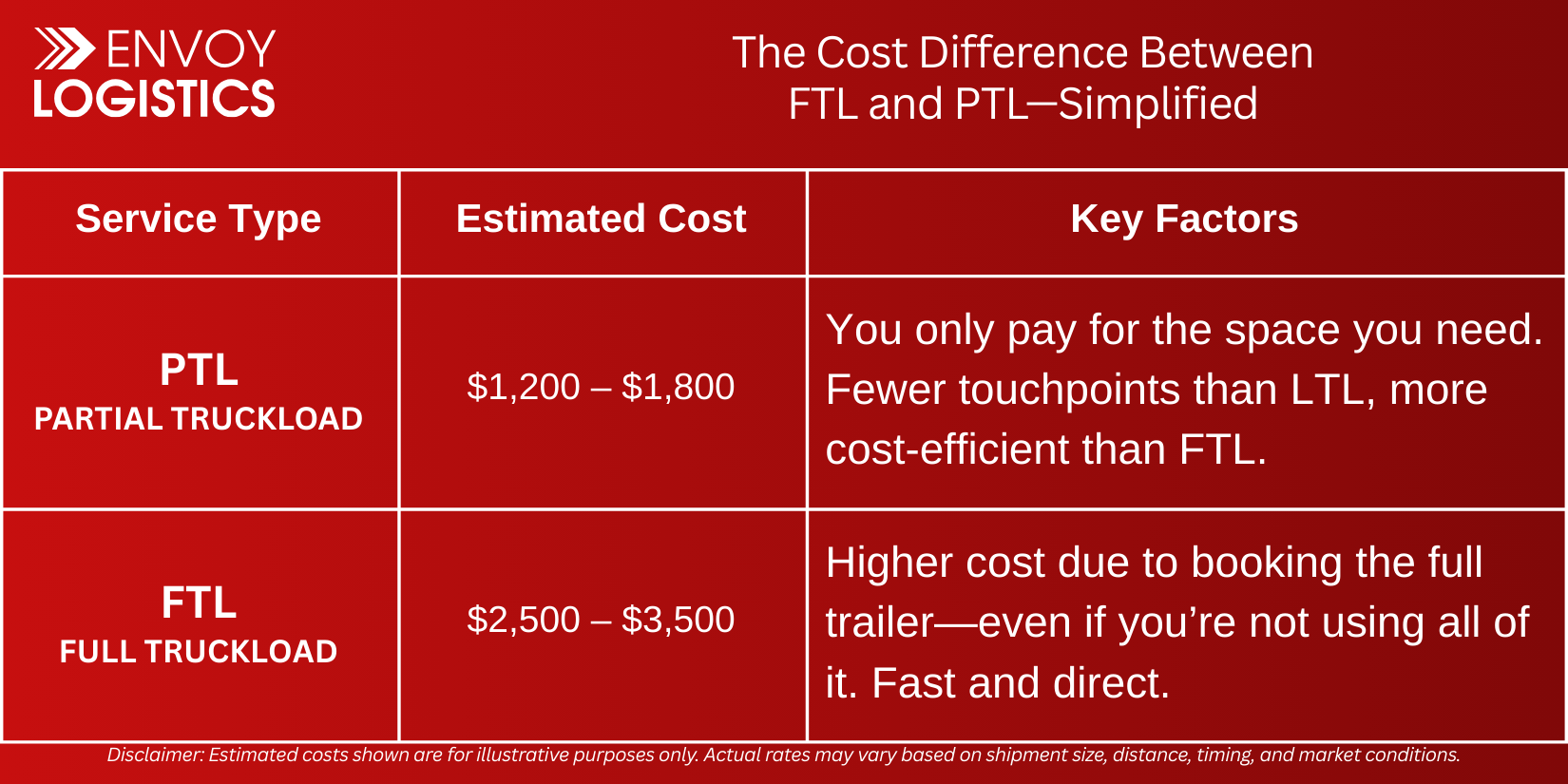FTL vs. PTL: What’s the Real Cost Difference—and When to Choose Each
When your freight doesn’t fill a full trailer, the choice between Full Truckload (FTL) and Partial Truckload (PTL) can feel like navigating a maze. The wrong decision can lead to overspending, delays, or unnecessary handling. This article clarifies the key differences, breaks down cost comparisons, and shares real-world examples to ensure shippers make informed choices every time.
Understanding the Basics:
Full Truckload (FTL)
FTL means your shipment occupies the entire truck—whether you need all the space or not. Ideal for large shipments, urgent timelines, or fragile and high-value goods, FTL minimizes handling and provides direct transit.
Partial Truckload (PTL)
PTL offers a cost-effective middle ground between LTL and FTL. You share trailer space with other shippers, but without the extensive handling typical of LTL. PTL shipments move directly from point A to point B, reducing touchpoints and potential risks.
Visualizing the Difference: PTL and FTL each serve a purpose—this side-by-side comparison highlights when to choose one over the other based on shipment size, timing, and handling needs.
When FTL Makes Sense:
Shipment fills most of the trailer.
Time-sensitive deliveries require direct transit.
Fragile or high-value goods demand minimal handling.
Avoidance of consolidation or transfers is crucial.
When PTL Is the Better Fit:
Freight exceeds LTL capacity but doesn’t warrant a full trailer.
Cost savings are a priority.
Flexible transit times (within reason) are acceptable.
Fewer touchpoints are desired without exclusive trailer use.
Cost Comparison:
PTL vs. FTL
Let’s examine a hypothetical shipment: a 15-pallet, 12,000-pound load.
Takeaway: For freight that doesn’t fill an entire trailer and isn’t time-critical, PTL often provides comparable results at a lower cost.
Real-World Examples:
A Common Misstep:
A small business shipping its first wholesale order—a 15-pallet load—opted for FTL without exploring alternatives. While the shipment moved smoothly, the invoice was nearly double the necessary cost. PTL could have delivered the same results at half the price. This highlights the importance of knowing your options.
How the Right Logistics Partner Makes a Difference:
The same scenario, but this time the business sought advice from Envoy Logistics. After reviewing shipment details, our team, as a trusted logistics partner, recommended partial truckload service. This cost-effective solution saved them over $1,000 compared to FTL, ensuring secure and on-time delivery.
What made this possible?
Logistics partners like Envoy Logistics excel in negotiating competitive rates and matching shippers with the ideal carrier. Thanks to our established relationships and consistent volume across numerous customers, we offer:
Better Rates
Carriers extend competitive pricing to partners who bring them steady business.
More Flexibility
With access to niche providers and regional carriers, we ensure the right fit for every shipment.
Faster Booking
Pre-existing relationships and contracts streamline the entire process.
With Envoy Logistics' guidance, this small business avoided unnecessary costs, gained peace of mind, and transformed an intimidating shipment into a seamless experience.
Navigating the FTL vs. PTL decision doesn’t have to be overwhelming. The right logistics partner—Envoy Logistics—ensures shipments are handled efficiently, cost-effectively, and without surprises.
Need help choosing the best option for your freight?
Contact Envoy Logistics today—we’re here to guide you every step of the way.
Want smarter shipping tips like this, straight to your inbox?
Sign up for The Envoy Editorial—our monthly newsletter packed with tools, trends, and real talk for shippers. Join the List
Need more freight know-how? Check these out:







